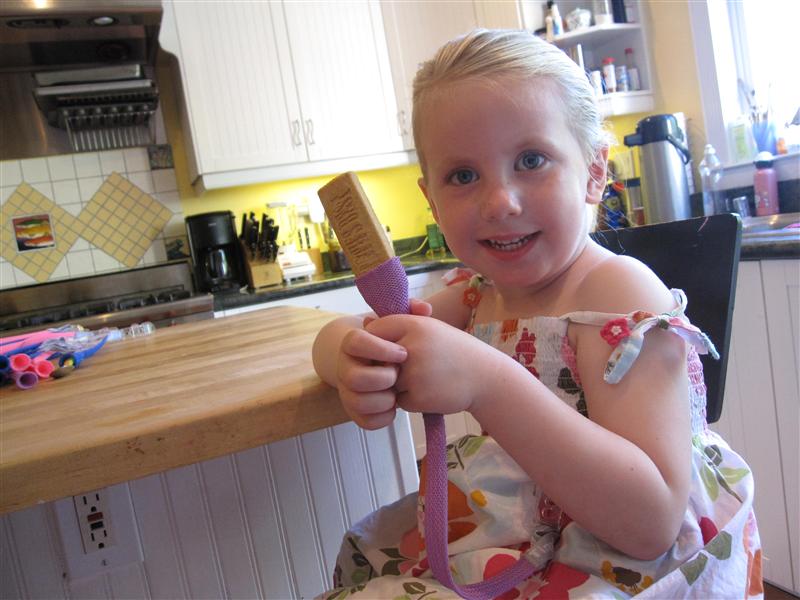
RETURN TO HOME PAGE
FEEDBACK
 |
November 2010 RETURN TO HOME PAGE FEEDBACK |
By Heather World
 |
| Tim McManus, wife Katrin, and 4-year-old daughter Ella demonstrate HandyBites, the teething tether that Tim invented to keep nibbles from dropping on the floor. Photo by Pamela Gerard |
Tim McManus and wife Katrin winced. For the third time in less than a minute, five-month-old daughter Ella had dropped to the floor the carrot sticks the staff of Mi Lindo Yucatan had so graciously brought to the lunch table. But then a lightbulb switched on in Tim’s head.
“I got to thinking of those ‘Chinese finger cuffs,’” said the 48-year-old Clipper Street resident, referring to a gag toy that tightens around your finger when you try to pull it out. The cuffs were not for Ella’s fingers, mind you, but to hold the carrot or teething biscuit she liked to gnaw on to soothe her gums.
Thus was born HandyBites, a teething tether that McManus designed to keep gnaw-ables within baby’s reach and off the floor. One end of the tether grips the food—or toy or rattle or toothbrush—and the other clips on to the child’s clothing.
“Originally, I just wanted to make something for us to use personally,” McManus relates, “but as we strolled around the neighborhood—hanging out in front of Martha’s, Bernie’s, and the farmers market—I got a lot of feedback from people encouraging me to actually try and convert this into a product.”
Though he handled the production and sale of the first 20,000 HandyBites himself, McManus recently licensed his tether design to Boon, Inc., a company that sells clever children’s products designed in a simple, modern way. Like other Boon products, the tether will be found in retail giants like Walmart, Target, and Babies “R” Us, as well as in specialty stores in 50 countries come January.
Luck and Work
McManus is no industrial engineer—he runs his own manufacturing consulting firm—and he credits his success with HandyBites to a mix of luck and hard work.
His first move back in 2007, after the dropped-carrot-lunch, was to look up Chinese finger cuffs in Wikipedia. There he learned that the mechanism behind trapping fingers was the toy’s “biaxial braided sleeve.” A Google search revealed that the biaxial braid has many industrial applications, so McManus found a supplier and requested a sample of the material for his prototype.
When it was finished, he sent his gadget to labs certified by the Consumer Product Safety Commission and asked them to test for common hazards, like choking, and to perform a chemical analysis. Results showed the material contained no Bisphenol A or phthalates, two plastic additives suspected of being dangerous to children.
“Here’s this thing used for industrial applications that’s actually made from material that’s safe enough for a baby to chew on,” he says.
Soon Ella had a HandyBites attached to her car seat, to her highchair, to her stroller. And she was eager to use it, her father says. When her biscuit was done, she knew how to hand the tether up to her parents for a refill even before she knew how to say “more,” McManus says.
Parents Eat It Up
Emboldened by his informal 24th Street focus group, McManus further tested the market waters by commissioning a small production run of HandyBites and selling them at the 2008 Harvest Festival. Parents ate it up, he says.
McManus, a Noe Valley resident since 1984, found neighborhood support beyond just parents, too. In the spring of 2009, Peekabootique’s Michele Furlong agreed to sell HandyBites at her store on Castro Street.
Made entirely in the United States, the tether sold for $8.95. In April 2009, McManus took it on the road and attended a trade show for children’s products. He signed up a number of “mom and pop” stores to carry HandyBites and found distributors as far away as Korea.
The idea, says McManus, was to prove to large distributors like Target that the product would sell. Though HandyBites was successful, its inventor was more than relieved when he attended his second trade show in December of 2009 and met Rebecca Finell, the designer behind Boon products.
This was the ABC Kids Expo in Las Vegas, the granddaddy of all “juvenile products” expos. Finell was looking for more products to complement her line, which to date had been designed entirely by herself. Of all the new ideas at the expo, only HandyBites appealed to her, she told McManus.
“She’s one of the most amazing designers I’ve ever seen,” he says. “I’m so flattered.”
The Next Bite
As a product in Finell’s stable, the teething tether will no longer be called HandyBites. Its new name is the Gnaw, in keeping with Boon’s IKEA-like product names. The Gnaw was launched at this year’s Las Vegas Expo, held in October.
Meanwhile, McManus has moved on to his next invention, an accessory used to prepare gourmet food.
“It’s a lot of work,” says McManus, estimating he spent around 400 hours on HandyBites—creating the prototype, taking photographs, designing the website, creating banners for the trade shows—before sending it to market.
Still, he hasn’t given up his day job of streamlining manufacturing processes.
“Now
that
I’ve
had
to
walk
the
walk
myself, I understand when I go into status
meetings and people don’t have their stuff done,” he says. “It’s hard.”